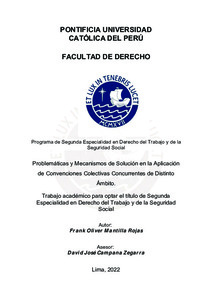| dc.contributor.advisor | Campana Zegarra, David José | |
| dc.contributor.author | Mantilla Rojas, Frank Oliver | |
| dc.date.accessioned | 2023-03-24T15:56:08Z | |
| dc.date.available | 2023-03-24T15:56:08Z | |
| dc.date.created | 2022 | |
| dc.date.issued | 2023-03-24 | |
| dc.identifier.uri | http://hdl.handle.net/20.500.12404/24521 | |
| dc.description.abstract | La posibilidad fáctica de la pluralidad de sindicatos al interior de una misma
empresa conforme a los datos de sindicación y negociación colectiva en el Perú
durante el año 2021; y, a su vez, la afiliación múltiple de un mismo trabajador a
dos o más sindicatos de distintos niveles de representación, conllevan a la
necesaria y adecuada regulación de la articulación de las convenciones
colectivas concurrentes en distintos ámbitos.
Esto no sería posible, sin la habilitación jurídica de la existencia de más de una
convención colectiva aplicable a un trabajador o grupo de trabajadores que
pueden afiliarse simultáneamente a más de una organización sindical, conforme
a nuestra legislación interna, siempre que pertenezcan a distinto ámbito.
Lo que nos conlleva analizar la regulación jurídica que asume nuestra legislación
respecto a la articulación de convenciones colectivas concurrentes plasmado en
el Art. 45° del D. S. N° 003-2010-TR, recientemente modificado por la segunda
disposición complementaria modificatoria de la Ley N° 31110 y, además, la
validez o eficacia del mismo acorde con nuestra realidad negocial donde
prepondera la hiperdescentralización de la negociación colectiva.
Este análisis amerita profundizar en las técnicas de articulación de fuentes
jurídicas y resolución de antinomias, pero desde el punto de vista de la libertad
sindical en los términos esbozados por los pronunciamientos de los órganos de
control de la OIT como mejores exponentes de este principio jurídico de alcance
internacional.
Así, se pretende revisar si nuestra legislación, acorde con la normatividad y
pronunciamientos del sistema internacional, prioriza la vigencia simultánea de
pluralidad de convenciones colectivas a través de su articulación y si recurre en
última instancia a la prevalencia de una de las convenciones concurrentes,
privilegiando el principio de la norma más favorable. | es_ES |
| dc.description.abstract | The factual possibility of the plurality of unions within the same company
according to the union and collective bargaining data in Peru during the year
2021; and, in turn, the multiple affiliation of the same worker to two or more unions
of different levels of representation, lead to the necessary and adequate
regulation of the articulation of concurrent collective agreements in different
surroundings.
This would not be possible, without the legal authorization of the existence of
more than one collective agreement applicable to a worker or group of workers
who can simultaneously join more than one trade union organization, in
accordance with our internal legislation, as long as they belong to a different area.
What leads us to analyze the legal regulation that our legislation assumes
regarding the articulation of concurrent collective agreements embodied in art.
45° of D. S. N° 003-2010-TR, recently modified by the second amending
complementary provision of Law N° 31110 and, in addition, the validity or
effectiveness of the same in accordance with our business reality where the
hyperdecentralization of collective bargaining prevails.
This analysis deserves to deepen the techniques of articulation of legal sources
and resolution of antinomies, but from the point of view of trade union freedom in
the terms outlined by the pronouncements of the ILO control bodies as the best
exponents of this legal principle scope international.
Thus, it is intended to review if our legislation, in accordance with the regulations
and pronouncements of the international system, prioritizes the simultaneous
validity of a plurality of collective agreements through its articulation and if it
resorts in last instance to the prevalence of one of the concurrent agreements,
privileging the principle of the most favorable norm. | es_ES |
| dc.language.iso | spa | es_ES |
| dc.publisher | Pontificia Universidad Católica del Perú | es_ES |
| dc.rights | info:eu-repo/semantics/openAccess | es_ES |
| dc.rights.uri | http://creativecommons.org/licenses/by/2.5/pe/ | * |
| dc.subject | Negociaciones colectivas de trabajo | es_ES |
| dc.subject | Libertad sindical | es_ES |
| dc.subject | Sindicatos | es_ES |
| dc.title | Problemáticas y Mecanismos de Solución en la Aplicación de Convenciones Colectivas Concurrentes de Distinto Ámbito | es_ES |
| dc.type | info:eu-repo/semantics/bachelorThesis | es_ES |
| thesis.degree.name | Segunda Especialidad en Derecho del Trabajo y de la Seguridad Social | es_ES |
| thesis.degree.level | Título Profesional | es_ES |
| thesis.degree.grantor | Pontificia Universidad Católica del Perú. Facultad de Derecho | es_ES |
| thesis.degree.discipline | Derecho del Trabajo y de la Seguridad Social | es_ES |
| renati.advisor.dni | 06178387 | |
| renati.advisor.orcid | https://orcid.org/0000-0003-1848-8799 | es_ES |
| renati.author.dni | 45357441 | |
| renati.discipline | 422059 | es_ES |
| renati.level | https://purl.org/pe-repo/renati/level#tituloSegundaEspecialidad | es_ES |
| renati.type | https://purl.org/pe-repo/renati/type#trabajoAcademico | es_ES |
| dc.publisher.country | PE | es_ES |
| dc.subject.ocde | https://purl.org/pe-repo/ocde/ford#5.05.01 | es_ES |







